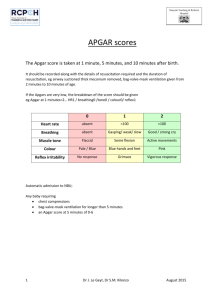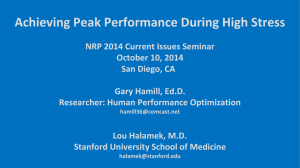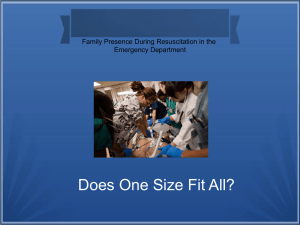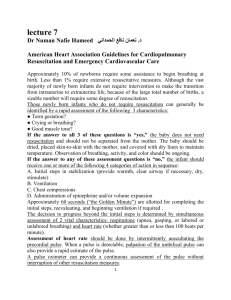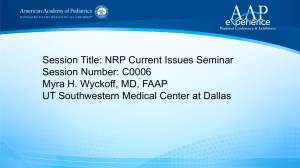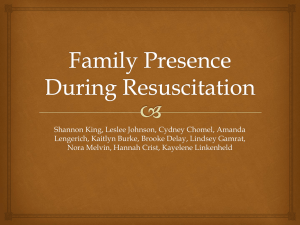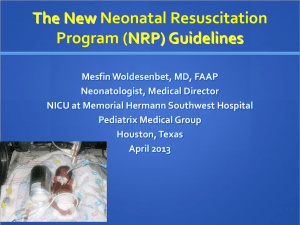Lesson 1
advertisement
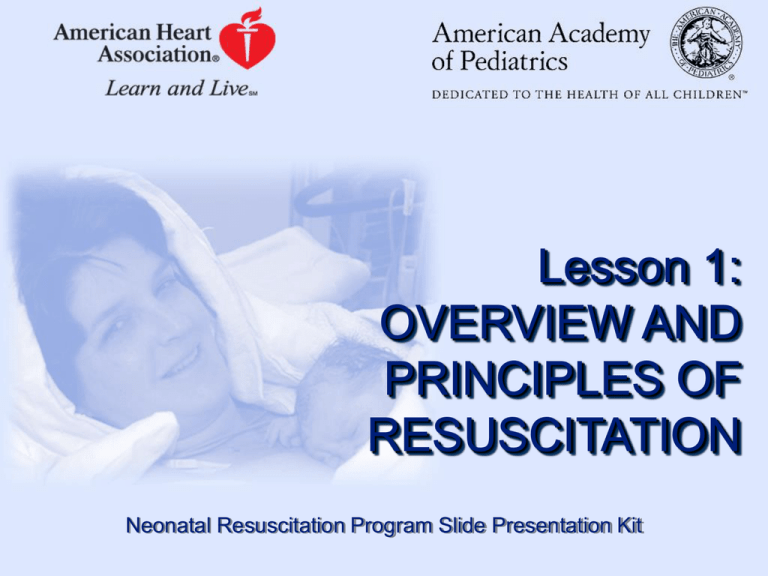
Lesson 1: OVERVIEW AND PRINCIPLES OF RESUSCITATION Neonatal Resuscitation Program Slide Presentation Kit Overview and Principles of Resuscitation Lesson content: • Physiologic changes at birth • Resuscitation flow diagram • Resuscitation risk factors • Equipment and personnel needed 1-2 Which Babies Require Resuscitation? • Most newly born babies are vigorous • Only about 10% of newborns require some assistance • Only 1% need major resuscitative measures (intubation, chest compressions, and/or medications) to survive 1-3 Fetal Physiology In the fetus • Alveoli filled with lung fluid • In utero, fetus dependent on placenta for gas exchange 1-4 Fetal Physiology In the fetus • Pulmonary arterioles constricted • Pulmonary blood flow diminished • Blood flow diverted across ductus arteriosus Click on the image to play video 1-5 Lungs and Circulation After Delivery • Lungs expand with air • Fetal lung fluid leaves alveoli Click on the image to play video 1-6 Lungs and Circulation • Pulmonary arterioles dilate • Pulmonary blood flow increases 1-7 Lungs and Circulation • Blood oxygen levels rise • Ductus arteriosus constricts • Blood flows through lungs to pick up oxygen Click on the image to play video 1-8 Normal Transition The following major changes take place within seconds after birth: • Fluid in alveoli absorbed • Umbilical arteries and vein constrict thus increasing blood pressure • Blood vessels in lung relax 1-9 What Can Go Wrong During Transition • Lack of ventilation of the newborn’s lungs results in sustained constriction of the pulmonary arterioles, preventing systemic arterial blood from being oxygenated • Prolonged lack of adequate perfusion and oxygenation to the baby’s organs can lead to brain damage, damage to other organs, or death 1-10 Signs of a Compromised Newborn • Poor muscle tone • Depressed respiratory drive • Bradycardia • Low blood pressure • Tachypnea • Cyanosis Good tone with cyanosis Bad tone with cyanosis 1-11 In Utero or Perinatal Compromise Primary Apnea • When a fetus/newborn first becomes deprived of oxygen, an initial period of attempted rapid breathing is followed by primary apnea and dropping heart rate that will improve with tactile stimulation 1-12 Secondary Apnea • If oxygen deprivation continues, secondary apnea ensues, accompanied by a continued fall in heart rate and blood pressure • Secondary apnea cannot be reversed with stimulation; assisted ventilation must be provided QuickTime™ and a Sorenson Video 3 decompressor are needed to see this picture. Click on the image to play video 1-13 Resuscitation of a Baby in Secondary Apnea Initiation of effective positive-pressure ventilation during secondary apnea usually results in • Rapid improvement in heart rate 1-14 Provider Response All newborns require initial assessment to determine whether resuscitation is required 1-15 Initial Steps (Block A) • Provide warmth • Position head and clear airway as necessary* • Dry and stimulate the baby to breathe *Consider intubation of the trachea at this point (for depressed newborn with meconium-stained fluid) 1-16 Evaluation After these initial steps, further actions are based on evaluation of • Respirations • Heart rate • Color You have approximately 30 seconds to achieve a response from one step before deciding to go on to the next 1-17 Breathing (Block B) If Apneic or HR < 100 bpm: • Provide positive-pressure ventilation* • If breathing, and heart rate is >100 bpm but baby is cyanotic, give supplemental oxygen. If cyanosis persists, provide positive-pressure ventilation *Endotracheal intubation may be considered at several steps 1-18 Circulation (Block C) If heart rate <60 bpm despite adequate ventilation for 30 seconds, • Provide chest compressions as you continue assisted ventilation* • Then evaluate again. If heart rate <60 bpm, proceed to Block D *Consider intubation of the trachea at this point 1-19 Drug (Block D) If heart rate <60 bpm despite adequate ventilation and chest compressions, • Administer epinephrine as you continue assisted ventilation and chest compressions* *Consider intubation of the trachea at this point 1-20 Important Points in the Neonatal Resuscitation Flow Diagram • The most important and effective action in neonatal resuscitation is to ventilate the baby’s lungs • Effective positive-pressure ventilation in secondary apnea usually results in rapid improvement of heart rate • If heart rate does not increase, ventilation may be inadequate and/or chest compressions and epinephrine may be necessary 1-21 Important Points in the Neonatal Resuscitation Flow Diagram • Heart rate <60 bpm → Additional steps needed • Heart rate >60 bpm → Chest compressions can be stopped • Heart rate >100 bpm and breathing → Positivepressure ventilation can be stopped • Asterisk (*): endotracheal intubation may be considered at several steps • Time line: if no improvement after 30 seconds, proceed to next step 1-22 Preparation for Resuscitation: Personnel and Equipment • Every delivery should be attended by at least 1 person whose only responsibility is the baby and who is capable of initiating resuscitation. Either that person or someone else who is immediately available should have the skills required to perform a complete resuscitation • When resuscitation is anticipated, additional personnel should be present in the delivery room before the delivery occurs • Prepare necessary equipment – Turn on radiant warmer – Check resuscitation equipment 1-23 Preparation for Resuscitation: Risk Factors • The majority, but not all, of neonatal resuscitations can be anticipated by identifying the presence of antepartum and intrapartum risk factors associated with the need for neonatal resuscitation 1-24 1-25 Why Are Premature Newborns at Higher Risk? • • • • • • • • Possible surfactant deficiency Decreased drive to breathe Rapid heat loss, poor temperature control Possible infection Susceptible to brain hemorrhage Susceptible to hypovolemia secondary to blood loss Weak muscles make spontaneous breathing difficult Immature tissues may be damaged by excessive oxygen 1-26 Three Levels of Postresuscitation Care 1-27
